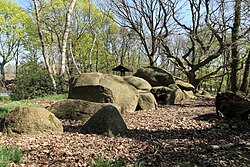Passage grave Groß-Stavern 1
| Passage grave Groß-Stavern 1 Large stone grave on Bruneforth's Esch | ||
|---|---|---|
|
|
||
| Coordinates | 52 ° 46 '58.3 " N , 7 ° 26' 11.2" E | |
| place | Stavern , Lower Saxony , Germany | |
| Emergence | 3500 to 2800 BC Chr. | |
| Sprockhoff no. | 846 | |
The passage grave Groß-Stavern 1 (also called Großsteingrab auf Bruneforths Esch) is a megalithic complex from the Neolithic Age and is located in a small wood west of the Bruneforth mill , which belongs to Groß-Stavern in the Emsland district in Lower Saxony . It is located immediately south of the road to Klein-Stavern. The passage grave of the funnel cup culture (TBK) was created between 3500 and 2800 BC. Chr. And bears the Sprockhoff no. 846. Neolithic monuments are an expression of the culture and ideology of Neolithic societies. Their origin and function are considered to be the hallmarks of social development. The passage grave is a form of Neolithic megalithic systems, which consists of a chamber and a structurally separated, lateral passage. This form is primarily found in Denmark, Germany and Scandinavia, as well as occasionally in France and the Netherlands.
description
The east-west-oriented megalithic complex of the Emsland Chamber type has an approximately 25-meter-long chamber, which tapers from the three-meter-wide center to both ends to about 1.8 meters. The system consists of eleven yokes. Four of the previously 30 bearing stones are missing, three of the original eleven cap stones are missing. In the middle of the south side there is a partially destroyed, three meter long and 0.7 meter wide entrance that protrudes far into the chamber. The two inner bearing stones of the corridor supported the much shorter central capstone in a way that is only found in this complex. Today the large stone grave is dominated by an old tree that stands in the middle of the chamber.
During excavations in the eastern part of the chamber at the beginning of the 19th century, H. Bödiker came across earth and diatoms mixed with broken glass. J. H. Müller found the remains of decorated urns in the chamber around 1864 , which point to subsequent burials in the complex. There is just as little evidence of a barren bed as a covering hill.
See also
- Nordic megalithic architecture
- The complex is on the street of the megalithic culture
literature
- Anette Bußmann : Stone Age witnesses. Travel to the prehistory of northwest Germany. Isensee Verlag, Oldenburg 2009, ISBN 978-3-89995-619-1 , pp. 63-64.
- Mamoun Fansa : large stone graves between Weser and Ems. Isensee Verlag, Oldenburg 1992, ISBN 3-89442-118-5 , pp. 56-57.
- JH Müller: Journal of the historical association for Lower Saxony . 1864, pp. 290f.
- H. Bödiker: In: Antiquities in the Meppen district. Archive for the history and antiquity of Westphalia . 2nd volume, Hamm 1828, pp. 179f.
- Ernst Sprockhoff : Atlas of the megalithic tombs Germany. Part 3: Lower Saxony - Westphalia. Rudolf Habelt Verlag, Bonn 1975, ISBN 3-7749-1326-9 , pp. 98-99.
Web links
Individual evidence
- ↑ J. Müller In: Varia neolithica VI 2009, p. 15

